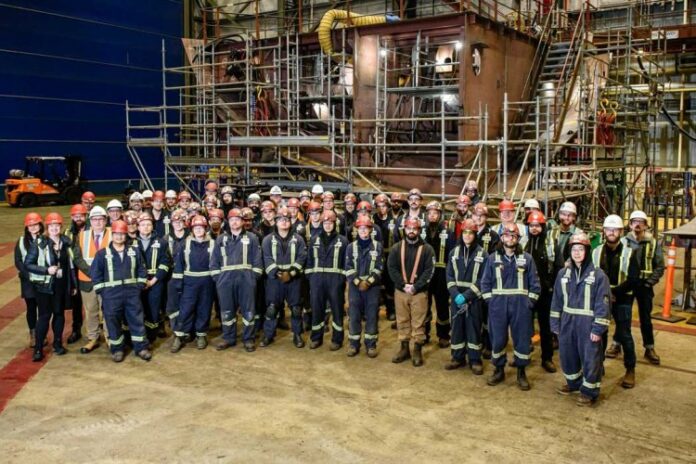Seaspan developed and built this Prototype Block to ensure that our production teams are fully prepared to cut steel on the Polar Icebreaker in late 2024.
The process of building the Prototype Block resulted in learnings in three key areas: improvements in design for manufacturing; testing of new equipment, processes and procedures; and validation of first-time quality in manufacturing to form and weld this new, specialized and thicker steel.
“Having the opportunity for our engineering and production teams to work collaboratively to construct this Prototype Block very early in the design process was beneficial not only to Seaspan, but also to our customer and our cross-county supply chain. We are all working toward the same goal of delivering the Polar Icebreaker to the Canadian Coast Guard. Our skilled trades team has now seen, felt, tested, and worked on this specialized steel, so we are now better prepared to ensure that Seaspan begins full rate construction with a more mature design,” said Martin Edwards, Chief Program Officer at Seaspan Shipyards.
Steel needed to construct the Polar Icebreaker is twice as thick in some areas as the steel Seaspan has used for the other ships built under the National Shipbuilding Strategy and is more challenging to work with combined with the tight frame spaces to support icebreaking capabilities. It also takes additional time to weld, and the thicker steel is not as malleable, therefore constructing this extra Prototype Block prior to starting full rate construction was crucial for our preparedness.
“The completion of the Prototype Block for our Polar Icebreaker is an important milestone for the Canadian Coast Guard. We eagerly await its delivery as this vessel will extend Coast Guard on-water operations and ensure the continuous delivery of critical services in the high Arctic. This includes search and rescue, environmental and humanitarian response, supporting important ocean science and arctic sovereignty,” said Mario Pelletier, Commissioner of the Canadian Coast Guard.
Seaspan has already gained significant experience designing and building Polar Class vessels including three Offshore Fisheries Science Vessels which are now in service with the Canadian Coast Guard; an Offshore Oceanographic Science Vessel that is currently under construction at its Vancouver Shipyards location; and a class of up to sixteen Multi-Purpose Vessels (also Polar Class) that is currently in design.
The Polar Icebreaker will be an incredibly complex ship, designed to operate in the Arctic’s ice-covered waters, and will play a critical role in enabling the Canadian Coast Guard to transit and operate on more than 162,000 km of Arctic coastline. The capabilities of the Polar Icebreaker will help sustain a year-round presence in Canada’s North in support of Indigenous Peoples and other northern communities, Arctic sovereignty, high-Arctic science (including climate change research), and the ability to respond to major maritime emergencies including search and rescue.
With Canada’s current largest Icebreaker, the CCGS Louis S. St-Laurent, set to retire at the end of the decade after 60 years of service, the new Polar Icebreaker will be one of the world’s largest and most powerful conventional icebreakers. The ship will be the flagship vessel of the Canadian Coast Guard’s icebreaking fleet, with a critical mission of protecting Canada’s Arctic sovereignty.
FACTS ABOUT THE POLAR ICEBREAKER
With a displacement of 27,876 tonnes, the Polar Icebreaker will be 158 metres long and 28 metres wide, and able to accommodate up to 100 personnel. It will be able to operate farther north, in more difficult ice conditions and for longer periods than any icebreaker in Canada to date.
Highlights of key design features, include:
- IACS Polar Class 2 (PC2) Heavy Icebreaker
- More than 40MW of installed power
- Ice-classed azimuthing propulsion system
- Complex, multi-role mission capability
- Scientific Laboratories
- Moon Pool (to allow for safe deployment of equipment from within the ship)
- Helicopter flight deck and Hangar
- Vehicle Garage and future Remotely Piloted Aircraft System (RPAS) capability



